Charlemagne's Palatine Chapel at Aachen (original) (raw)
 Aachen: Charlemagne's Palatine Chapel
(Bell tower of St. Gangolf's at Trier seen from Porta Nigra)
Aachen: Charlemagne's Palatine Chapel
(Bell tower of St. Gangolf's at Trier seen from Porta Nigra)
You may wish to see an introductory page to this section first.
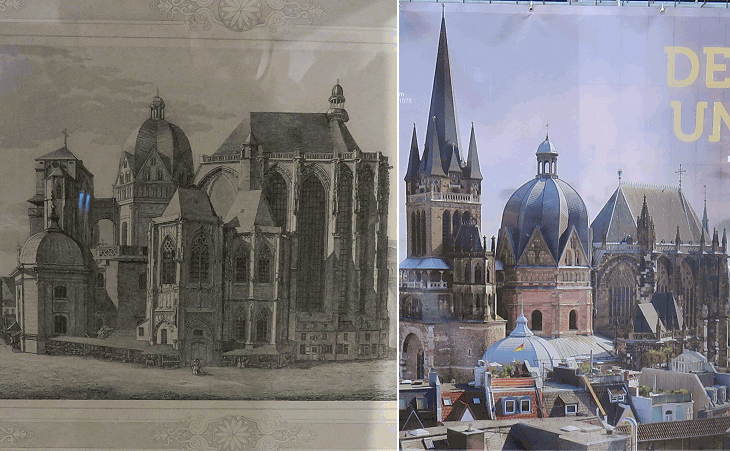
## The Cathedral with the octagonal Palatine Chapel in an early XIXth century print (left) and in a modern poster (right); the images show the Gothic Revival additions
It is agreed to have been a very ancient City, but the Beginnings of it are somewhat disputed. (..) The Low Dutch call the City Aken, the Germans Aach, and the French Aix, contracted from Eaux which in their Language signifies Waters. They have added the Words la Chapelle by reason of the Famous Chapel built there by Charlemaigne. (..) Charlemaigne made this City the Seat of his Empire on this side of the Alps and by an old Custom the Emperors of Germany have been wont to be crown d here. (..) Charlemaigne spent good part of his Life here and at last died in this City in the Year of our Lord 814 and was buried in the Church which he built. (..) He erected this at his own Charge and brought hither Pope Leo III and Three hundred sixty three Bishops to the Consecration of it in the Year 804. Theophilus Dorrington - Some reflections made in a journey through Germany in the year 1698 The Dom Kirche (Cathedral) consists of two parts erected at different times, in different styles. The nave, or octagon, with round arches, stands on the spot where Charlemagne had erected "the chapel," after which the city was named. (..) It is decidedly one of the oldest buildings in Germany. John Murray - A Hand-Book for Travellers on the Continent - 1838

## (left) The Cathedral seen from its eastern end; (right) drum and dome of the Palatine Chapel
Aix la Chapelle or Aken is a city of Germany (..) twenty six miles north east of Liege and thirty west of Cologne. It is a large populous town and of a very great antiquity. (..) The town is situated in a fruitful valley surrounded with mountains and woods. (..) The only religion here tolerated is the Roman catholic, but the protestants are permitted to reside in the town and to resort to a church in the neighbourhood. (..) The great church is a Gothic building with a high steeple at the west end adorned with pyramids and covered with a cupola in the middle. Thomas Nugent - The Grand Tour - 1749 The basilica at Aix-la-Chapelle was a great work considering its age and situation. It was destined by Charlemagne to be also his tombhouse, and here he was in fact afterwards buried. (..) The splendour of this church, says Eginhardt (a courtier and biographer of Charlemagne), was the expression of his Christian devotion. He adorned it with gold and silver, and lights, and with doors and screens of solid bronze (the image used as background for this page shows a detail of a bronze door). Hither he would come to the service morning and evening and even by night as long as his health permitted. (..) The exterior has now a monstrous fluted (late XVIIth century) dome of timber and slate, somewhat grotesque: but probably it had originally a plain pyramidal roof rising from walls carried up as a drum, concealing the dome. Thomas Graham Jackson - Byzantine and Romanesque Architecture - 1913

## Interior of the Palatine Chapel
That which was properly Charlemaigne's Chapel is a round Building and very dark. As soon as one is enter d a Man finds himself under a broad dark Isle, if I may so call it which goes round the Church. Dorrington On the inside are a vast number of pillars, of brass and marble gilded statues, brazen doors, and a great deal of Mosaic work. Nugent The building was something of an exotic in the kingdom of the Austrasian Franks in the VIIIth century, and no one who has seen it and also S. Vitale, the church at Ravenna from which it is supposed to have been imitated, can doubt its foreign origin. Eginhardt tells us that Charlemagne imported columns and marbles for the work from Ravenna and Rome, and he is supposed to have stripped and ruined the splendid palace of Theodoric at the former city, which has now practically disappeared. But besides materials, there can be little doubt he also imported from Italy his architect and his principal builders. The resemblance to S. Vitale is very strong, and yet there is sufficient difference to show that the builders were men of originality, able to think for themselves, not tied to a simple imitation of their model, and there could have been no such men in Austrasia then. (..) Some would have it that Eginhardt himself, who is described as "operum regalium exactor" and "variarum artium doctor peritissimus", was the architect of the building. It is more probable that, like Julianus Argentarius at Ravenna, he was the administrator of the expenses. (..) But his building set no general example, and when German Romanesque (see a page on the Romanesque churches of Cologne)began to assume the character of a definite style, we find the basilican type of church accepted for general use. Jackson
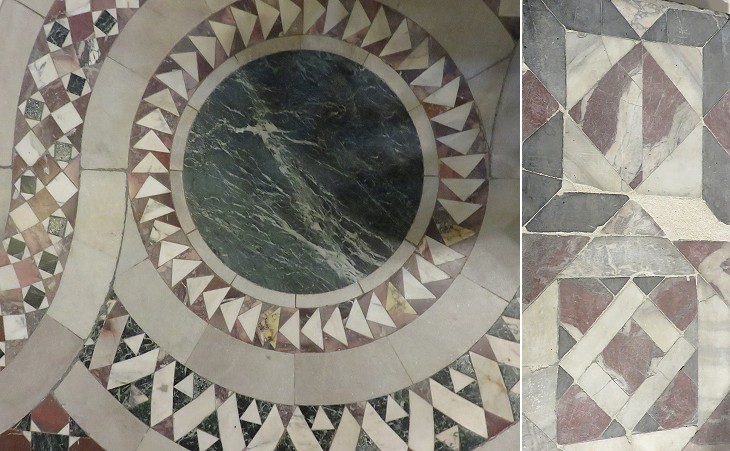
## (left) 1913 floor imitating ["opus Alexandrinum" aka Cosmati work](Glossar2.html#Cosmati work); (right) Rheinische Landesmuseum Bonn: tiles of the original floor
The stunted proportion of the lower order and the absence of bases give the impression that the floor level has been raised. Jackson The new floor was the last of a series of changes brought about in the period 1869-1913, which included the removal of Baroque decoration and plaster, the marble cladding of the walls of the octagonal aisle and mosaics on its vaults which vaguely resemble those of Mausoleo di Galla Placidia at Ravenna.

## Galleries (see also those of Sts. Sergius and Bacchus' at Constantinople)
Both churches have a dome over an octagon, a surrounding aisle in two storeys, though a women's gallery was not required by the Latin use, two staircases by which to mount to it at the west end enclosed in circular turrets; and though at Aix there are no exedrae, the arches of the upper gallery have colonnettes in them recalling those at Ravenna, and they have even something like a pulvino on their capitals. Although the diameter of the dome is less than that at S. Vitale by more than ten feet, still a domed building even of these dimensions would be a considerable undertaking at any time, and it is carried out in a very scientific manner. Jackson

## Rheinische Landesmuseum Bonn: a granite column from the Palatine Chapel
After the peace of Paris, Aix was separated from France, to which it had been united by Napoleon, and added to the dominions of the King of Prussia. (..) The front of the gallery was originally adorned with 32 pillars of granite and porphyry: (..) these were somewhat wantonly removed by the French, and as only a part of them have been returned from Paris, they have not been replaced. Murray Among the capitals some are antique Corinthian, but most of them have been renewed: and of the columns which were carried off by French invaders to Paris not all have come back. Jackson
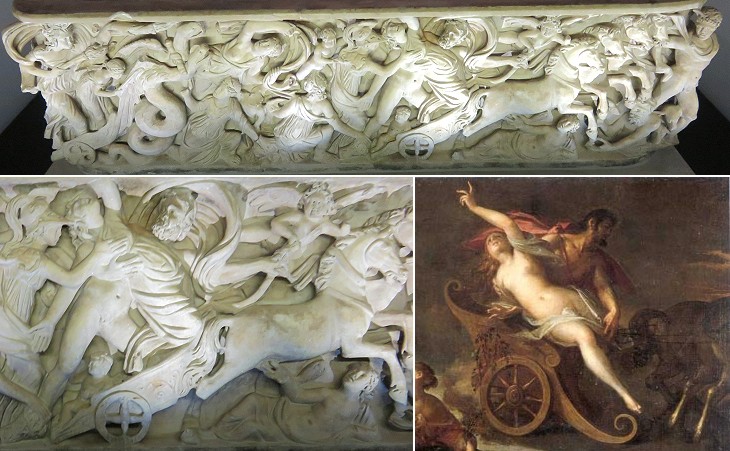
## (above and below-left) Sarcophagus of the Rape of Proserpina (or Kore/Persephone, read the story about her rape); (below-right) a detail of a 1589 painting by Hans von Aachen (Brukenthal Museum, Sibiu)
We were then shewn the fine coffin of white marble, on which there is an alt relief of the rape of Proserpine; it is kept locked in a nich, in which there is a bust to the middle of Charlemagne: This relief is executed in the highest taste: Charon's long-boat seems to be the scene of the whole, who sits rowing in it: Towards the head of the boat is a chariot drawn by four horses, represented with great force and fire; there is a cupid behind Pluto; a person in armour is behind Proserpine, both as to hinder her from going away, and from looking back; he also has a cupid behind him; last of all there is a chariot of Furies drawn by two dragons with wings, as driving over the women of Proserpine, with their baskets of fruits and flowers. Richard Pococke - A Description of the East and Some Other Countries - 1745 The sarcophagus was most likely brought to Aachen from Rome. It is made of Lunense (Carrara) marble; it influenced local Renaissance artists and it did not escape the attention of the French who moved it to Paris. You may wish to see another sarcophagus depicting the same subject at the Archaeological Museum of Catalonia in Barcelona.

## Chandelier donated by Emperor Frederick Barbarossa; it was decorated with small silver statues inside sort of small temples and with a silver band between the inscriptions; the silver parts were removed and melted by the French; (inset) first words of the inscription
The position of the Tomb, in which once reposed the mortal remains of Charlemagne, is marked by a large slab of marble under the centre of the dome, inscribed with the words "Carolo Magno". A massive brazen chandelier hangs above it, the gift of the Emperor Frederick Barbarossa. Murray The chandelier was meant to symbolize Celica Iherusalem (*) (Heavenly Jerusalem), as indicated by the first words of the inscription; this was more evident before the French robbed it of its silver decoration. Frederick, who quarrelled with the Popes all his life, dictated a very lengthy sentence pleading the Virgin Mary for being admitted to Heaven with Beatrice of Burgundy, his second wife whom he married in 1156. (*) I saw the Holy City, the new Jerusalem, coming down out of heaven from God, prepared as a bride beautifully dressed for her husband. Apocalypse - 21:2 - New International Version
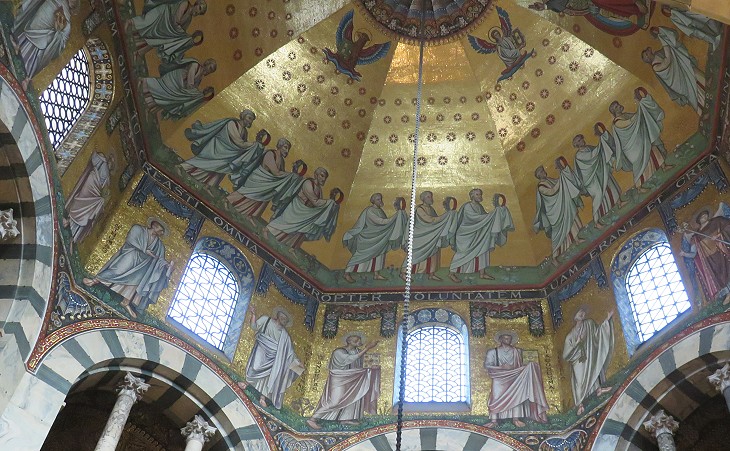
## 1881 mosaic decoration of the dome
There is a Painting on the Arch of the Cupolo, which has been fine, but has now not only lost its Beauty, but is so decay d one cannot well tell what to make of it. Time and hard Usage have defaced the Beauty of this Church extreamly and depriv d it of Finery and Riches, which it was formerly possessed of. Dorrington It appears that the dome was embellished with a painting, but in the 1870s, in order to emphasize the Byzantine character of the chapel it was decided to redecorate it with a mosaic based on a XVIIth century drawing of the painting. The cartoons were designed by Jean-Baptiste Bethune, a Belgian architect and decorator, and they were executed by the Venetian mosaicist Antonio Salviatis. The final work resembles those at the Arian Baptistery and at other monuments of Ravenna.
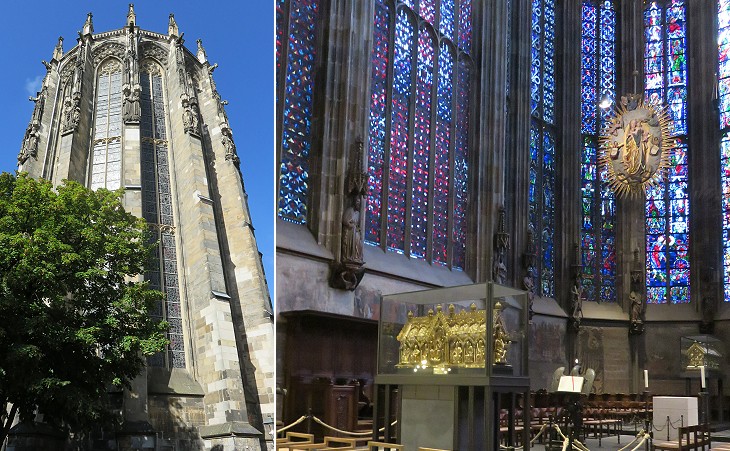
## (left) Apse of the addition to the Chapel housing the tomb of German Emperor Otto III; (right) nave replacing the ancient choir and linking the Chapel to Otto's tomb
On the East side of the ancient and first Chapel, is now a magnificent and large Quire, almost as big as the other; this is very light with great Windows made after the later Fashion. Dorrington The Choir, a more modern addition, begun in 1353, finished 1413, is of prodigious height (114 ft.) and lightness, having the appearance of a stupendous lantern, all of glass. Murray The original choir was short, like that of S. Vitale, and in 1353 it was replaced by the present long building, a veritable lantern of late German Gothic. Its expanded circular end is supposed to represent on the same foundations the tomb-house of Otho III who died in 1002, and who was supposed by some to have re-built Charlemagne's church. James Fergusson (a Scottish art historian) believes the truth to be that he built himself a tomb-house where the choir now ends, which the 14th century architect united by the present choir to the 8th century building. Jackson
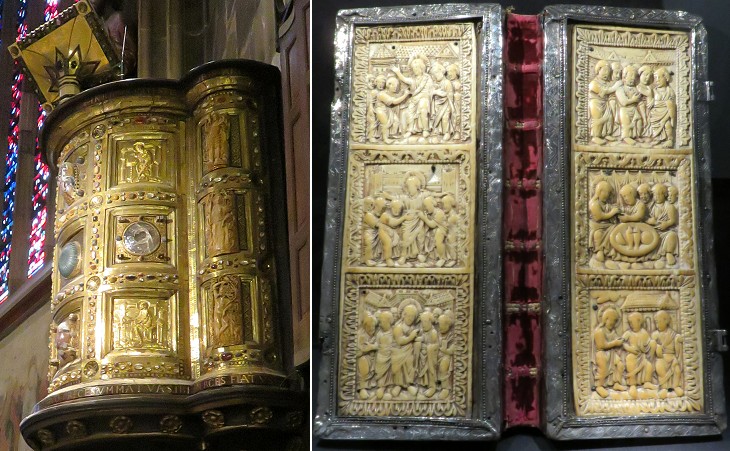
## Embellishments and donations: (left) pulpit built by Henry II, the last of the Ottonian Emperors; (right) ivory cover of a prayer book donated by Charles III or the Fat, a great-grandson of Charlemagne
For the space of above 500 years several emperors successors to Charlemaine were crowned at here with the first crown, for formerly the emperor received three crowns: the first of iron in this city from the elector of Cologne, the second of silver at Milan from the archbishop of Milan, and a third of gold at Rome from the pope. The emperor Charles IV made a positive regulation of this ceremony in 1356 by one of the constitutions of the Golden Bull which ordained that the emperor should receive his first crown here; but the custom of crowning with three crowns has been long since laid aside. Nugent The Choir contains a pulpit, covered with plates of silver gilt, richly ornamented with carvings in ivory, and precious stones: this is concealed, however, as well as protected, by a wooden case, which the assistance of the sacristan will remove. Murray Many emperors embellished the Chapel or made donations to its treasury in the period it was used for coronation ceremonies.
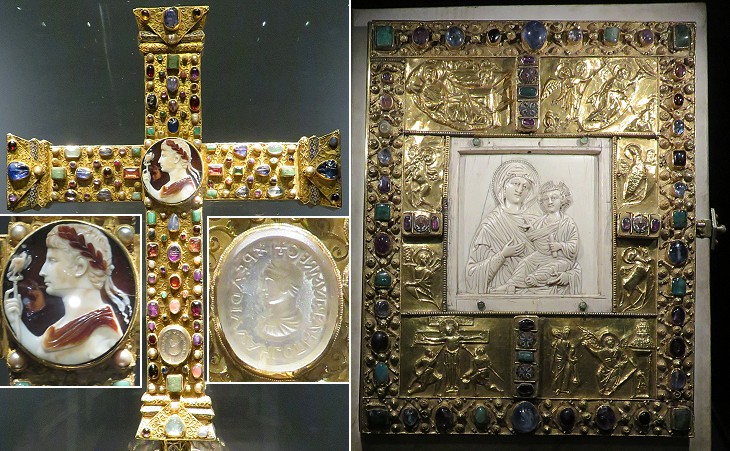
## (left) Lothair's Cross, a gift by Emperor Otto III (see the Cross of Desiderius at Brescia); it is embellished with a Roman cameo portraying Emperor Augustus (see a very similar one) and with a seal of Lothair II, another great-grandson of Charlemagne who was King of Lotharingia (855-869), a partition of the Carolingian Empire which included Aachen; (right) gemstones and gold book cover with an ivory Byzantine icon portraying the Virgin Mary indicating Jesus Christ as the Messiah (Hodegetria, she who shows the way), a gift by Emperor Henry II
The treasury of this church is famous for its relics a particular description ot which would be too tedious here to mention. Nugent The Treasury of the church is very rich in relics, some of which are considered so sacred that a priest must be summoned to display them. The others, called the Petites Reliques, are shown by the sacristan. The Grandes Reliques are publicly shown to the people only once in seven years, from the 15th to 27th of July. (..) Intermixed with these religious reliques are many curious antique gems (..), which serve as jewels to ornament the saintly treasury. Murray
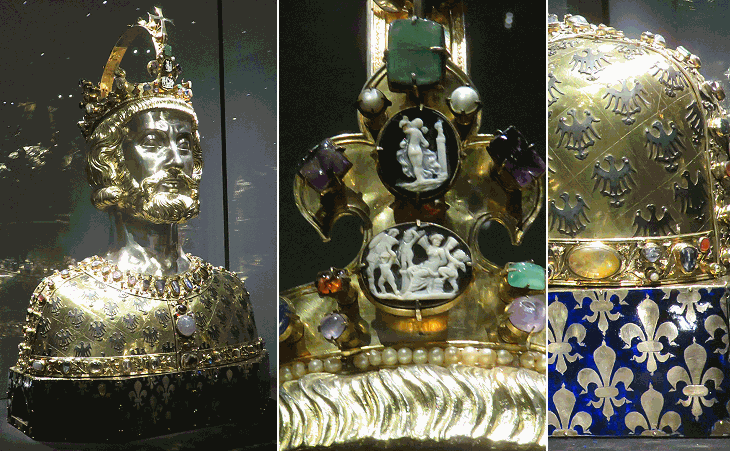
## (left) Reliquary with the skull of Charlemagne; (centre) Roman cameos; (right) eagles, the heraldic symbol of the Holy Roman Empire, and fleurs-de-lis which, before becoming the heraldic symbol of the Kings of France, were associated with the early Frankish kings and therefore with Charlemagne
The vault below is now empty, having been opened by the Emperor Otho in 997. He found the body of Charlemagne not reclining in his coffin, as is the usual fashion of the dead, but seated in his throne as one alive, clothed in the imperial robes, bearing the sceptre in his hand, and on his knees a copy of the Gospels. On his fleshless brow was the crown, the imperial mantle covered his shoulders, the sword Joyeuse was by his side, and the pilgrim's pouch, which he had borne always while living, was still fastened to his girdle. (..) Among the relics are several curiosities not appertaining to saints, such as the skull of Charlemagne, enclosed in a silver case, something like a barber's block, and his arm-bone, both taken, it is said, from his grave, and the only fragments of his body remaining in the church, all the rest having been carried off as relics. Murray The reliquary was donated by Charles IV, who most likely was enthroned with its crown in 1349.

## Schnutgen Museum at Cecilienkirche in Cologne: two panels of the Harrach Diptych ca 800 from Aachen (see another ivory panel from Aachen at Narbonne)
Ivory carvings became popular in Rome in the IVth century AD as a luxury gift (see items which belonged to a Roman senator); later on the finest works were made at Constantinople and some of them came into the possession of Charlemagne who promoted the development of local ivory carving workshops. They perhaps used walrus tusk, rather than elephant ivory.
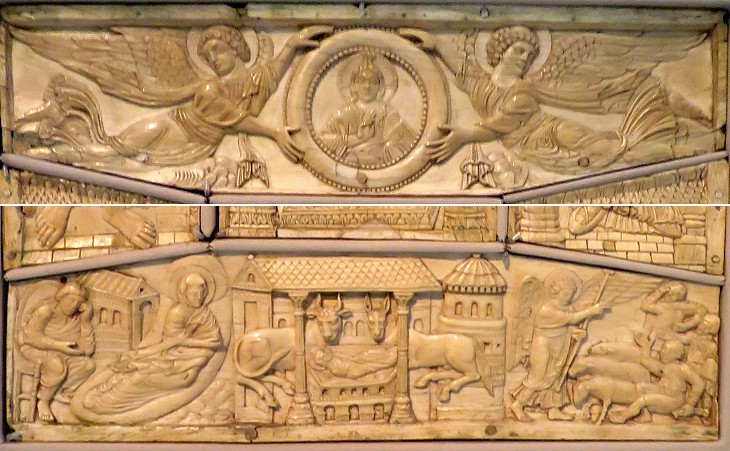
## Victoria and Albert Museum - Lorsch Gospel ivory cover ca 800, most likely a gift from Charlemagne
Coeval with Charlemagne's basilica at Aquisgranum, or possibly a little earlier, is the little chapel at Lorsch, near Worms, which is generally supposed to be part of the monastery dedicated in the presence of Charlemagne in 774. Jackson